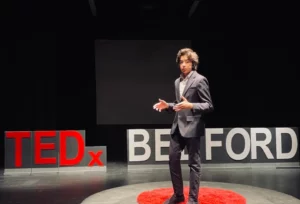On a humid summer night in 2018, Elon Musk took the stage at a Tesla investor event with an audacious promise – his company would start producing an affordable electric vehicle at volumes greater than those of Ford and GM within just two years, contributing to Elon Musk charismatic leadership.
For most onlookers, it sounded like pure hubris from the controversial billionaire CEO.
After all, Tesla had just undergone “production hell” struggles in ramping up its mainstream Model 3.
Skeptics dismissed his ambitious claims as more delusional bluster destined to disappoint.
But for Musk’s legion of devout followers, that moment simply reaffirmed why they revere him as a real-life Tony Stark – an uncompromising visionary with the charismatic audacity to reimagine the impossible.
Tesla
Based in Silicon Valley, Tesla was founded in 2003 with a pioneering mission – to accelerate the world’s transition to sustainable energy through electric vehicles and renewable power generation.
After achieving early success with its premium Roadster model, the company revealed its first mass-market offering in 2017, the Model 3 sedan.
Priced at just $35,000, it represented Tesla’s bid to truly disrupt the automotive industry’s long-held gasoline-powered paradigm.
Despite its innovative products and bold vision, bringing Tesla into mainstream viability has been an immense uphill battle.
The capital-intensive process of building out manufacturing capacity and streamlining production has repeatedly strained the company’s finances.
Time and again, Musk has found himself making grandiose projections to win over shareholders and generate hype, only for his timelines to get pushed back amid nagging operational struggles.
Meanwhile, skeptics have frequently derided him as a wildly overpromising con artist detached from reality.
The Core Issue
From its earliest days, Tesla has been defined by Musk’s stratospheric ambitions for upending transportation as we know it.
What began as him simply wanting to build “a freakin’ awesome electric car” rapidly spiraled into grander visions – fully renewable energy capability for entire towns; a nationwide charging infrastructure; eventually self-driving vehicles that could redefine urban mobility itself.
But as the company grew from a Silicon Valley garage into a global manufacturing behemoth, Musk’s soaring rhetoric and boundary-pushing deadlines began creating chronic whiplash.
While his bold claims ignited a passionate, cult-like zeal from customers and investors eagerly buying into the Tesla dream, they also repeatedly set unrealistic expectations that fueled perpetual disappointment.
Overpromising and underdelivering became a constant cycle that eroded Musk’s credibility.
Missed production targets, vehicle delays, worker safety issues, and cash crunches culminated in 2018’s “Production Hell” fiasco with the Model 3.
This perfect storm finally forced Musk to directly confront a harsh truth – his charismatic showmanship was increasingly being perceived as more sideshow than substance by critics and regulators.
“Musk has brilliantly capitalized on his abilities as a storyteller to arouse visceral passion for his vision,” remarked Stanford Professor Anat Lechner, an expert on business charisma.
The Pivot: Elon Musk Charismatic Leadership
In the aftermath of 2018’s “Production Hell“, Musk and Tesla’s leadership made moves to pivot the narrative around his leadership and the company’s execution abilities:
- Operational Restructuring – The C-suite expanded with seasoned auto manufacturing experts like former Daimler executive Jerome Guillen to run day-to-day vehicle operations.
- Revised Projections – Following the botched Model 3 ramp, Tesla got more conservative in setting public timelines for future product launches and capacity expansions to curb missed targets
- Culture Refocus – Internal memos and messaging from Musk stressed a “Stakeholder Capitalism” philosophy aimed at aligning all employees behind delivering on promises to customers as priority #1, ahead of excessive showmanship. A focus on transparency and ownership over past failings.
- Strategic Shifts – Distracting campaigns like the aborted take-Tesla-private saga and early autonomous taxi promises were dialed back as the company redirected efforts toward establishing steadier financial footing and improving fundamentals. Non-core projects like the Roadster update were deprioritized for leaner execution.
- Union Concessions – Tesla finally reached a deal with labor unions, allowing the EV maker to rapidly scale up production capacity in exchange for improved worker protections and profit-sharing incentives.
- New Product Pacing – Rather than rushed, overhyped timelines, Musk shifted to setting clear multi-year roadmaps for new model launches providing ample cushion to fortify operations and manufacturing.
- Musk Brand Evolution – The CEO’s public behavior shifted to strike more humility and showcase renewed commitment to proving sustainable execution. His once erratic tweets and media feuds calmed as he focused persona on advancing Tesla’s product realities.
While continuing to uphold Tesla’s visionary ambitions, this pragmatic reset aimed to curb disillusionment by better synchronizing Musk’s charismatic influence with provable real-world capabilities.
Tesla’s pivot toward a more calibrated balance between Musk’s bold futurism and systematic execution has yielded undeniable results:
- Rebounded Production – After 2018’s “Production Hell”, Model 3 output steadily ramped up to over 300,000 vehicles by the end of 2019. More recently, the company’s new factories in Berlin and Austin have minimized chaos in launching new models.
- Financial Turnaround – Years of cash burning flipped to sustained profitability and positive free cash flow generation. Tesla’s market capitalization skyrocketed to over $1 trillion.
- Renewed Growth – The leaner product roadmap and smoother rollouts have catalyzed strong demand for successive models like the Model Y crossover and Cybertruck, accelerating Tesla’s expansion.
- Elevated Brand Credibility – While Musk’s diehard supporters never wavered, broader public perception of Tesla shifted from speculative hype toward credible innovative disruptors. Awards and accolades affirmed its leadership.
After years of perpetual chaos amid bold growth attempts, Musk’s refocused balance between ambitious vision and systematic execution established Tesla’s longevity. His charismatic influence remains as strong as ever, yet channeled toward tangible long-term success.
Key Learnings of Elon Musk Charismatic Leadership
Elon Musk’s evolution at Tesla spotlights the delicate balance transformative leaders must strike between idealistic vision-casting and pragmatic operational realities, especially when scaling world-changing ambitions.
Musk’s charismatic abilities to inspire stakeholders around his products’ purpose proved invaluable in overcoming daunting challenges.
However, failing to pair that influence with systematic foundations and execution discipline ultimately eroded credibility.
Only by harnessing his charisma as a catalytic force yet anchoring it to operational consistency could Musk deliver on Tesla’s potential.
Surrounding himself with experienced executors while projecting humbler realism allowed his evangelizing strengths to shine.
This balanced interplay between aspiration and action highlights the importance of complementing inspirational leadership with methodical capability-building.
Charisma may spark the movement, but it’s meticulous delivery that sustains it.





